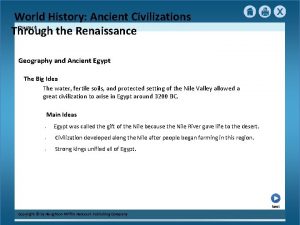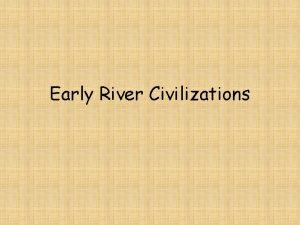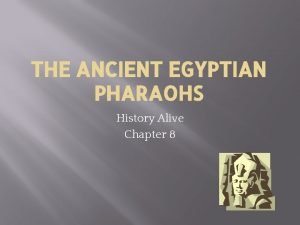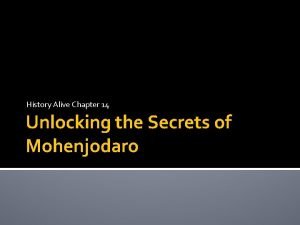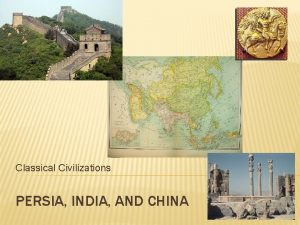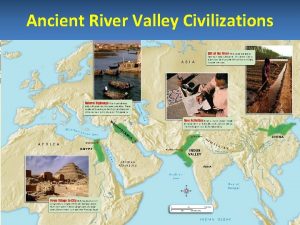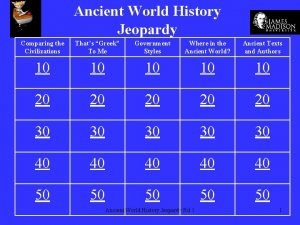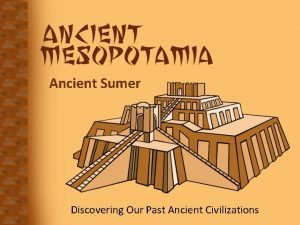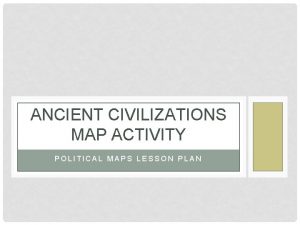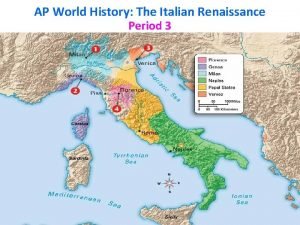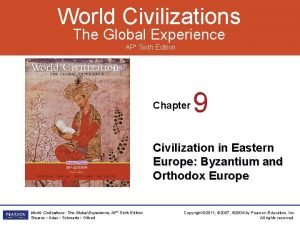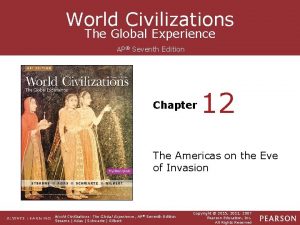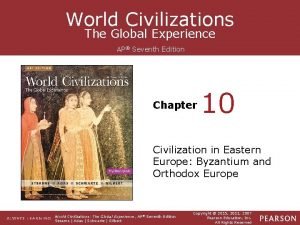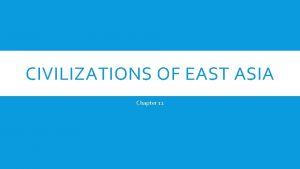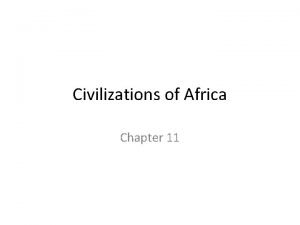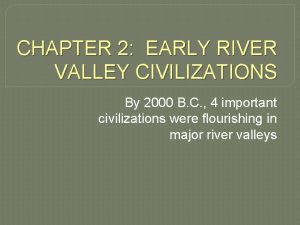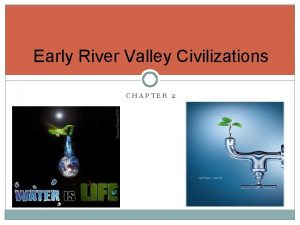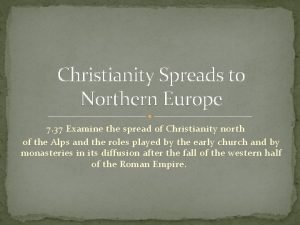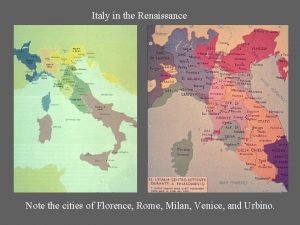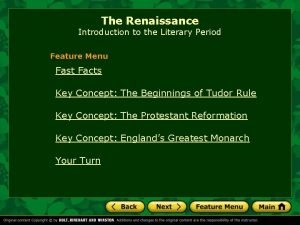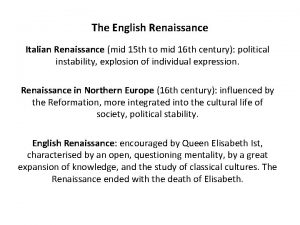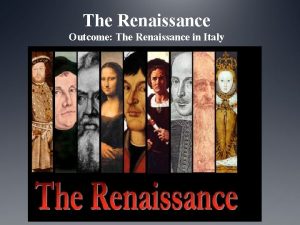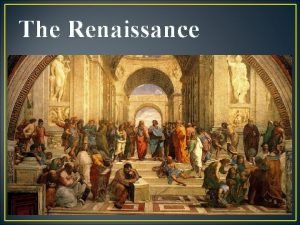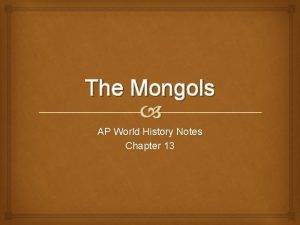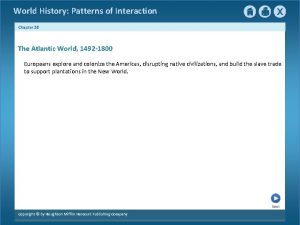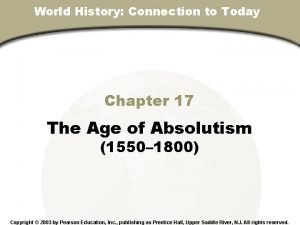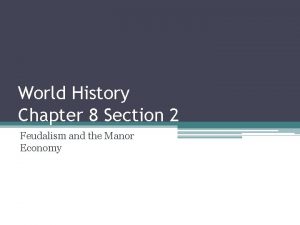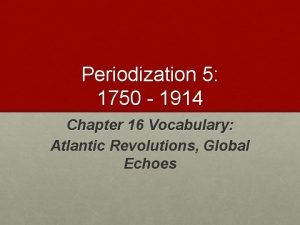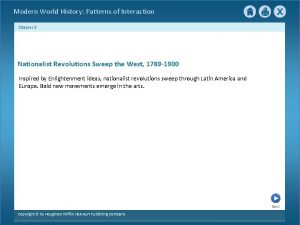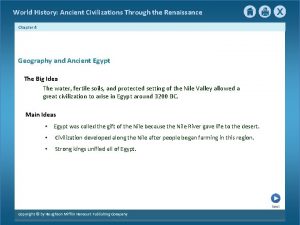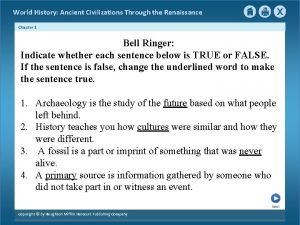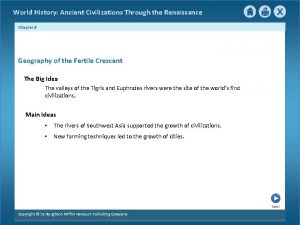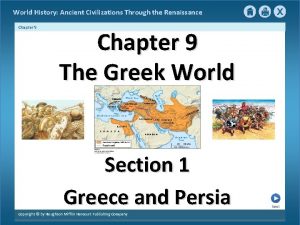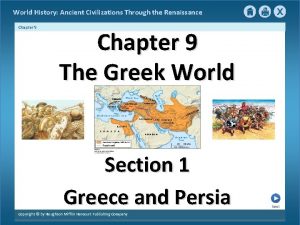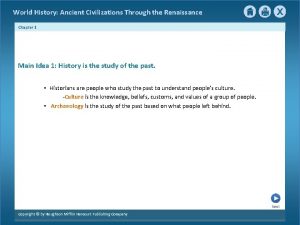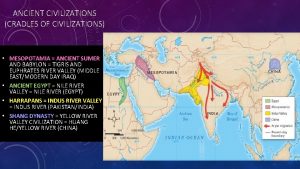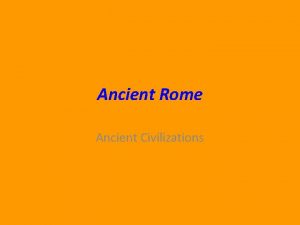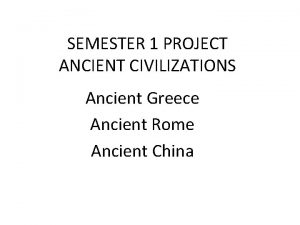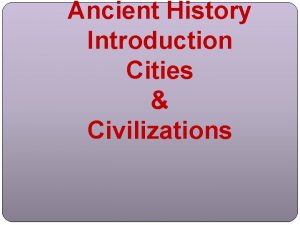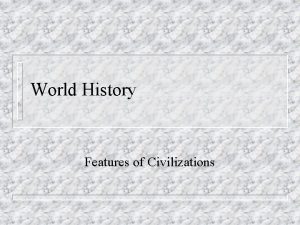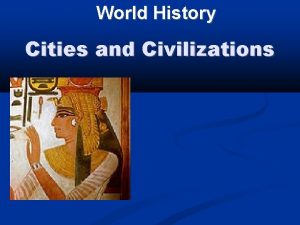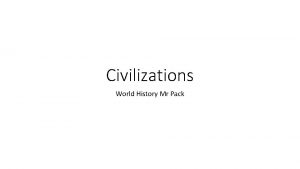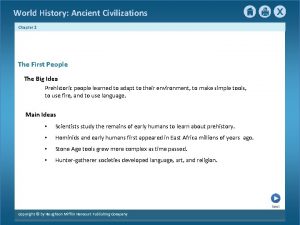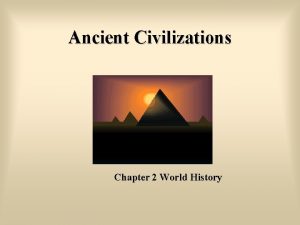World History Ancient Civilizations Through the Renaissance Chapter





















































- Slides: 53

World History: Ancient Civilizations Through the Renaissance Chapter 9 The Greek World Section 1 Greece and Persia Copyright © by Houghton Mifflin Harcourt Publishing Company Next

World History: Ancient Civilizations Through the Renaissance Chapter 9 Greece and Persia The Big Idea Over time the Persians came to rule a great empire which eventually brought them into conflict with the Greeks. Main Ideas • Persia became an empire under Cyrus the Great. • The Persian Empire grew stronger under Darius I. • The Persians fought Greece twice in the Persian Wars. Next Copyright © by Houghton Mifflin Harcourt Publishing Company

World History: Ancient Civilizations Through the Renaissance Chapter 9 Main Idea 1: Persia Becomes an Empire • Created in about 550 B. C. , the Persian Empire grew very quickly and spanned from Egypt in the west to Turkey in the north, and through Mesopotamia to the Indus River in the east. • Persia is today the country of Iran. • By the 5 th century B. C. , it was the largest empire the world had ever seen. Previous Copyright © by Houghton Mifflin Harcourt Publishing Company Next

World History: Ancient Civilizations Through the Renaissance Chapter 9 Cyrus the Great • Cyrus II defeated a people called the Medes (meedz) in 550 B. C. and marked the beginning of the Persian Empire. • Cyrus also added a great deal of land to the empire, stretching from India to the border of Egypt. Next Copyright © by Houghton Mifflin Harcourt Publishing Company

World History: Ancient Civilizations Through the Renaissance Chapter 9 Cyrus the Great • Cyrus II was a unique ruler because he let the people he conquered keep their own customs and religions, making them less likely to rebel. • When Cyrus conquered Babylon, he allowed the Jews enslaved there to return home. • Cyrus also created the Cyrus Cylinder, the world’s first declaration of human rights. Next Copyright © by Houghton Mifflin Harcourt Publishing Company

World History: Ancient Civilizations Through the Renaissance Chapter 9 The Persian Army • Cyrus was successful in his conquests because he had a strong, well organized, and loyal army. • The army was composed 10, 000 soldiers called the Immortals, archers, and a cavalry, soldiers on horseback. • Used in tandem (together), the Persian army was a deadly force. Previous Copyright © by Houghton Mifflin Harcourt Publishing Company Next

World History: Ancient Civilizations Through the Renaissance Chapter 9 Main Idea 2: The Persian Empire Grows Stronger • After Cyrus died, his son Cambyses took the throne. • Cambyses died soon after during a rebellion. • Within four years of Cambyses’ death, a young prince named Darius I claimed the throne. • He killed all his rivals for power and then worked to restore order in Persia. Previous Copyright © by Houghton Mifflin Harcourt Publishing Company Next

World History: Ancient Civilizations Through the Renaissance Chapter 9 Persian Society • Darius improved Persia: ü Organized the empire into 20 provinces, each led by a governor called a satrap (SAY-trap). ü Built many roads that connected various parts of the empire, including the 1, 700 mile long Royal Road. ü Built a new capital, called Persepolis. • During his rule a new religion arose, called Zoroastrianism. -This religion taught that two forces were fighting in the universe: a good force and an evil force. Previous Copyright © by Houghton Mifflin Harcourt Publishing Company Next

World History: Ancient Civilizations Through the Renaissance Chapter 9 Main Idea 3: The Persians Fight Greece • In 499 B. C. , several Greek cities in Asia Minor rebelled against Persian rule. • City-states in mainland Greece sent soldiers to help their fellow Greeks. • Although the Persians put down the rebellion, Darius was furious and swore to get revenge on the Greeks. Previous Copyright © by Houghton Mifflin Harcourt Publishing Company Next

World History: Ancient Civilizations Through the Renaissance Chapter 9 The Battle of Marathon • Nine years after the Greek rebellion, the Persians attacked Greece at the plains of Marathon, near Athens. • The Athenian army was outnumbered nearly two to one, but were able to defeat the Persians Previous Copyright © by Houghton Mifflin Harcourt Publishing Company Next

World History: Ancient Civilizations Through the Renaissance Chapter 9 The Battle of Marathon • According to legend, the Athenians sent the messenger Pheidippides (fy*dip*uh*deez) 25 miles to Athens with news of their victory. • Pheidippides collapsed from exhaustion and died. • Modern marathon races are named for this famous run and are just over 26 miles long. Previous Copyright © by Houghton Mifflin Harcourt Publishing Company Next

World History: Ancient Civilizations Through the Renaissance Chapter 9 The Second Invasion of Greece • Darius’s son Xerxes I took the throne after his death. • In 480 B. C. , ten years after the Battle of Marathon, Xerxes tried to conquer Greece again. • Sparta and Athens joined forces to defend against Xerxes’s attack, along with about 30 other Greek city- states. Previous Copyright © by Houghton Mifflin Harcourt Publishing Company Next

World History: Ancient Civilizations Through the Renaissance Chapter 9 The Second Invasion of Greece • Spartan King Leonidas ( lee*ah*nuh*duhs) led the Greeks against the Persians. • The Athenian general Themistocles (thuh*mihs* tuh*kleez) came up with a naval plan to cut supplies to the Persian army. • The Greeks fought the Persians at Thermopylae (thehr*mah*puh*lee), a narrow pass through the mountains. Previous Copyright © by Houghton Mifflin Harcourt Publishing Company Next

World History: Ancient Civilizations Through the Renaissance Chapter 9 • About 7, 000 Greeks held off the Persians for two days. • A traitor showed the Persians a mountain path that would allow them to get around the Greeks and attack from behind. • Knowing they would soon be trapped, Leonidas sent most of the army back to Athens, staying behind with 300 of his Spartans and about 1, 000 other soldiers. Previous Copyright © by Houghton Mifflin Harcourt Publishing Company Next

World History: Ancient Civilizations Through the Renaissance Chapter 9 • The remaining brave soldiers fought to their deaths. • The Persians finally make it to Athens and the city is burned. • A few days later the Greeks defeated the Persian navy at the Battle of Salamis (SAH-luh-muhs). • In 479 B. C. , Greek city-states came together to form the largest Greek army ever assembled and crushed the Persians at Plataea (pluh*tee*uh). Previous Copyright © by Houghton Mifflin Harcourt Publishing Company Next

World History: Ancient Civilizations Through the Renaissance Chapter 9 Section 2 Previous Sparta and Athens Copyright © by Houghton Mifflin Harcourt Publishing Company Next

World History: Ancient Civilizations Through the Renaissance Chapter 9 Sparta and Athens The Big Idea The two most powerful city-states in Greece, Sparta and Athens, had very different cultures and became bitter enemies in the 400 s BC. Main Ideas • The Spartans built a military society to provide security and protection. • The Athenians admired the mind and the arts in addition to physical abilities. • Sparta and Athens fought over who should have power and influence in Greece. Previous Copyright © by Houghton Mifflin Harcourt Publishing Company Next

World History: Ancient Civilizations Through the Renaissance Chapter 9 Main Idea 1: Spartans Build a Military Society • Spartan society was dominated by the military. • This type of society was thought to be created by Lycurgus (ly -KUHR-guhs) between 900 and 600 B. C. • Spartans believed a strong military power would provide security and protection. Previous Copyright © by Houghton Mifflin Harcourt Publishing Company Next

World History: Ancient Civilizations Through the Renaissance Chapter 9 Spartan Boys and Men • The Spartans valued discipline, obedience, and courage above all else. • Spartan babies were not allowed to live if there was a physical defect of any kind. • Sports and exercise were used to increase strength. Previous Copyright © by Houghton Mifflin Harcourt Publishing Company Next

World History: Ancient Civilizations Through the Renaissance Chapter 9 Spartan Boys and Men Ages 7 -12 • Values Training • Boys left home and received a basic education Ages 12 -18 • Physical Training • Boys developed skills through experience Ages 18 -20 • Military Training • Men learned how to fight as part of the army Ages 20 -30 • Military Service • Soldiers formed the body of the Spartan army • Could return home at age 30 Ages 30 -60 • Full Citizenship • Soldiers could participate in the assembly and move back home Previous Stayed the army Copyright © by Houghton • Mifflin Harcourtin Publishing Companyuntil the age of 60 Next

World History: Ancient Civilizations Through the Renaissance Chapter 9 Spartan Girls and Women • Because men were often at war, Spartan women had more rights than other Greek women. Ø -They ran the household and owned property. Ø -They also received physical training that would help them bear healthy children. Previous Copyright © by Houghton Mifflin Harcourt Publishing Company Next

World History: Ancient Civilizations Through the Renaissance Chapter 9 Government • The Spartan government was an oligarchy containing two branches: a council of elders and an assembly. • Two kings headed the council of elders which included 28 citizens over the age of 60. • All Spartan men over the age of 30 belonged to the assembly. Previous Copyright © by Houghton Mifflin Harcourt Publishing Company Next

World History: Ancient Civilizations Through the Renaissance Chapter 9 Government and Society • The Spartan government was set up to control the city’s slaves, called helots (HEL-uhts). • Helots’ lives were miserable and greatly outnumbered Spartan citizens, but did not rebel for fear of the Spartan army Previous Copyright © by Houghton Mifflin Harcourt Publishing Company Next

World History: Ancient Civilizations Through the Renaissance Chapter 9 Government and Society • To maintain control of the city-state, the Spartan government: ü kept out foreign visitors ü banned foreign travel for any reason except military ü frowned upon its citizens studying literature or the arts • Although Sparta had a superior army, it fell behind other Greeks in trade, science, and other subjects. Previous Copyright © by Houghton Mifflin Harcourt Publishing Company Next

World History: Ancient Civilizations Through the Renaissance Chapter 9 Main Idea 2: The Athenians Admired the Mind • Athens was the main rival of Sparta and often fought as enemies. • Although they too had a powerful army, life in Athens was very different from life in Sparta. Previous Copyright © by Houghton Mifflin Harcourt Publishing Company Next

World History: Ancient Civilizations Through the Renaissance Chapter 9 Boys and Men in Athens • The Athenians believed in training BOTH the body and the mind and believed educated people made the best citizens. • Boys had to learn to train and fight, but it was not as harsh as in Sparta. • Athenians valued education and learned reading, writing, math, music, and literature. Previous Copyright © by Houghton Mifflin Harcourt Publishing Company Next

World History: Ancient Civilizations Through the Renaissance Chapter 9 Boys and Men in Athens • Athenian men only had to serve in the army for two years, between the ages of 18 and 20. • Boys from rich families could continue their education through private tutors (philosophy, geometry, astronomy, public speaking). • Boys from poor families became farmers or craftspeople. Previous Copyright © by Houghton Mifflin Harcourt Publishing Company Next

World History: Ancient Civilizations Through the Renaissance Chapter 9 Girls and Women in Athens • Most girls only learned household tasks, but girls from wealthy families were sometimes taught by tutors. • Despite Athens’s reputation for freedom and democracy, women had very few rights. Women could not: Ø Serve in the government Ø Leave their homes except on special occasions Ø Buy anything or own property Ø Disobey their fathers or husbands Previous Copyright © by Houghton Mifflin Harcourt Publishing Company Next

World History: Ancient Civilizations Through the Renaissance Chapter 9 Main Idea 3: Sparta and Athens Fight – Athenian Power • After the Persian Wars, many city-states joined an alliance, which historians call the Delian League. -“Alliance” means they agreed to work together. • Athens was the strongest member of the Delian League and began to abuse its power. • Sparta formed its own alliance, called the Peloponnesian League and declared war on Athens. Previous Copyright © by Houghton Mifflin Harcourt Publishing Company Next

World History: Ancient Civilizations Through the Renaissance Chapter 9 The Peloponnesian War • In 431 B. C. , Sparta surrounded Athens and burned their crops in the hopes that by cutting their supplies, Athens would surrender. • However, the Athenian navy was able to get supplies into the city. • In the second year of the war, a deadly disease spread through the over-crowded city of Athens. • The Plague of Athens killed more than a third of the people, including Pericles in 429 B. C. Previous Copyright © by Houghton Mifflin Harcourt Publishing Company Next

World History: Ancient Civilizations Through the Renaissance Chapter 9 The Peloponnesian War • After 10 years of fighting, Athens and Sparta agreed to a truce. • A few years later, in 415 B. C, Sparta was able to defeat Athens while they were weakened by war elsewhere. • With the defeat of Athens, Sparta controlled nearly all of Greece for about 30 years. • Soon, other city-states started to resent Spartan rule and control of Greece shifted for many years leaving them weakened and vulnerable. Previous Copyright © by Houghton Mifflin Harcourt Publishing Company Next

World History: Ancient Civilizations Through the Renaissance Chapter 9 Section 3 Alexander the Great Previous Copyright © by Houghton Mifflin Harcourt Publishing Company Next

World History: Ancient Civilizations Through the Renaissance Chapter 9 Alexander the Great The Big Idea Alexander the Great built a huge empire and helped spread Greek culture into Egypt and Asia. Main Ideas • Macedonia conquered Greece in the 300 s BC. • Alexander the Great built an empire that united much of Europe, Asia, and Egypt. • The Hellenistic kingdoms formed from Alexander’s empire blended Greek and other cultures. Previous Copyright © by Houghton Mifflin Harcourt Publishing Company Next

World History: Ancient Civilizations Through the Renaissance Chapter 9 Main Idea 1: Macedonia Conquers Greece • In 359 B. C. , Philip II became king of Macedonia and wanted to conquer Greece. • He defeated Athens and their ally city-state Thebes, and as a result, the rest of Greece agreed to make Philip their leader. Previous Copyright © by Houghton Mifflin Harcourt Publishing Company Next

World History: Ancient Civilizations Through the Renaissance Chapter 9 Philip’s Military Strength • Philip was a brilliant military leader and improved many Greek battle strategies. • His soldiers fought as a phalanx with spears that were longer than the Greeks and also had cavalry and archers for support. • After Greece, Philip intended to conquer the Persian Empire, but was murdered in 336 B. C. before he could. Previous Copyright © by Houghton Mifflin Harcourt Publishing Company Next

World History: Ancient Civilizations Through the Renaissance Chapter 9 Main Idea 2: Alexander the Great Builds an Empire • Philip’s son, Alexander, took the throne of Macedonia at the age of 20. • After Philip’s death, the Greek city-state of Thebes rebelled. • Alexander destroyed the rebellion and enslaved the Theban people as an example to other Greeks. Previous Copyright © by Houghton Mifflin Harcourt Publishing Company Next

World History: Ancient Civilizations Through the Renaissance Chapter 9 Building a New Empire • Alexander went on to conquer Egypt and was crowned pharaoh without a fight in 332 B. C. • He then defeated Persia and became the ruler of the Persian Empire. Previous Copyright © by Houghton Mifflin Harcourt Publishing Company Next

World History: Ancient Civilizations Through the Renaissance Chapter 9 Marching Home • Alexander led his army through Central Asia and crossed the Indus River in 327 B. C. , intending to push deeper into India. • Battle weary and exhausted, his soldiers refused to go any further. • Alexander stopped in Babylon in 323 B. C. on his way home and fell ill. • He died a few days later at the age of 33. Previous Copyright © by Houghton Mifflin Harcourt Publishing Company Next

World History: Ancient Civilizations Through the Renaissance Chapter 9 Spreading Greek Culture • Alexander admired Greek culture and worked to spread it throughout his empire: Ø Modeled new cities after Greek cities, naming many Alexandria after himself Ø Built temples and theatres like those in Greece Ø Encouraged Greek settlers to move to these new cities Ø Greek became the common language Previous Copyright © by Houghton Mifflin Harcourt Publishing Company Next

World History: Ancient Civilizations Through the Renaissance Chapter 9 Spreading Greek Culture • Alexander also encouraged conquered people to keep their own customs and religions. • As a result, Greek and native customs blended, combining elements of Persian, Egyptian, Syrian, and other cultures. • Historians call this new culture Hellenistic, or Greek-like. Previous Copyright © by Houghton Mifflin Harcourt Publishing Company Next

World History: Ancient Civilizations Through the Renaissance Chapter 9 Main Idea 3: Hellenistic Kingdoms • After Alexander died, his generals fought for power and divided the empire among themselves. • The three kingdoms were: ü Macedonia ü Greece ü Syria. • Macedonia had the weakest government and had to put down many Greek revolts. • Syria included most of the former Persian Empire and was weakened by rebellions against Hellenistic rule. • Egypt, especially Alexandria, became a great cultural center and lasted the longest. Previous Copyright © by Houghton Mifflin Harcourt Publishing Company Each empire was eventually taken over by the Romans: ü Macedonia in the mid-100 s B. C. ü Syria in the 60 s B. C. ü Egypt in 30 B. C. Next

World History: Ancient Civilizations Through the Renaissance Chapter 9 Section 4 Previous Greek Achievements Copyright © by Houghton Mifflin Harcourt Publishing Company Next

World History: Ancient Civilizations Through the Renaissance Chapter 9 Greek Achievements The Big Idea Ancient Greeks made lasting contributions in the arts, philosophy, and science. Main Ideas • The Greeks made great contributions to the arts. • The teachings of Socrates, Plato, and Aristotle are the basis of modern philosophy. • In science, the Greeks made key discoveries in math, medicine, and engineering. Previous Copyright © by Houghton Mifflin Harcourt Publishing Company Next

World History: Ancient Civilizations Through the Renaissance Chapter 9 Main Idea 1: The Arts • The Greeks made many notable achievements in art, including sculpture, painting, architecture, and writing. • Marble and stone sculptures were carved to look perfect. • Greek paintings are admired for their realism and detail. • Scenes from mythology or battles were painted on vases or pots, often only using red and black. Previous Copyright © by Houghton Mifflin Harcourt Publishing Company Next

World History: Ancient Civilizations Through the Renaissance Chapter 9 Main Idea 1: Greek Architecture • Architecture is the art of designing building structures • The most important architecture were temples dedicated to a god or goddess: best-known is the Parthenon, dedicated to Athena • The Greeks used three different styles of columns in their buildings: Ionic, Doric, Previous and Corinthian Copyright © by Houghton Mifflin Harcourt Publishing Company Next

World History: Ancient Civilizations Through the Renaissance Chapter 9 New Forms of Writing • The Greeks excelled at writing and created new writing forms, including drama and history. • Two types of dramas were created: comedies and tragedies ü Tragedy: a person struggles to overcome difficulties, but fails, and has an unhappy ending. ü Comedy: the drama has a happy ending Previous Copyright © by Houghton Mifflin Harcourt Publishing Company Next

World History: Ancient Civilizations Through the Renaissance Chapter 9 New Forms of Writing Previous Copyright © by Houghton Mifflin Harcourt Publishing Company Next

World History: Ancient Civilizations Through the Renaissance Chapter 9 Greek Historians • Greeks wrote the first real histories in Western civilization. • In 435 B. C. , a Greek named Herodotus (hih*rah*duh*tuhs) wrote the history of the Persian Wars. • Western historians consider him the “father of history. ” • Thucydides (thoo*sih*duh*deez) is considered the greatest historian of the ancient world. • An Athenian soldier in the Peloponnesian War, he wrote History of the Peloponnesian War. Previous Copyright © by Houghton Mifflin Harcourt Publishing Company Next

World History: Ancient Civilizations Through the Renaissance Chapter 9 Main Idea 2: Greek Philosophy • The word philosophy comes from the Greek word for “love of wisdom. ” • Greek thinkers who believed in the power of the human mind and didn’t rely on explanations from mythology, were called philosophers. • Greek philosophers developed ideas that are still used today and led to the study of history, political science, and mathematics. Previous Copyright © by Houghton Mifflin Harcourt Publishing Company Next

World History: Ancient Civilizations Through the Renaissance Chapter 9 Socrates, Plato, and Aristotle Socrates � � � Thinker/teacher who believed that an absolute truth existed and that all real knowledge was within each person Invented new questioning style of teaching called the Socratic Method Athenian leaders thought that Socrates questioned the authority of the gods and taught the youth to rebel, so they sentenced him to death by poison Plato � Philosopher/teacher and student of Socrates � Created a school called the Academy � Wrote a book called The Republic � Believed in a society based on justice and fairness for everyone (men and women) � Believed government should be led by philosophers Previous Copyright © by Houghton Mifflin Harcourt Publishing Company Aristotle � Student of Plato and considered by many to be the greatest of the Greek thinkers � Taught that people should lives of moderation and balance: ü “golden mean”: – a person should do nothing in excess � Taught that people should govern themselves using reason – clear and ordered thinking � He opened his own school called the Lyceum. Next

Greek Scientists/Mathematicians and Their Contributions Archimedes Established the science of physics – figured out the value of pi (used to measure the area of circles) “Solid Geometry “ – study of spheres and cylinders Explained the lever and compound pulley Aristarchus Established that Earth revolves around the sun Eratosthenes Figured out that Earth is round Measured Earth’s circumference within 185 miles of actual distance Euclid Greek mathematician who wrote about “plane geometry” that shows how points, lines, angles, and surfaces relate to one another Wrote book, Elements Hipparchus Created a system to explain how planets and stars move Hippocrates Known as the “Father of Medicine” First to write a medical code of good behavior Hypatia Expanded knowledge of mathematics and astronomy Pythagoras First to establish the principles of geometry Pythagorean Theorem – used to determine the length of the sides of a triangle

World History: Ancient Civilizations Through the Renaissance Chapter 9 This is the end of the chapter presentation of lecture notes. Click the HOME or EXIT button. Previous Copyright © by Houghton Mifflin Harcourt Publishing Company Next

World History: Ancient Civilizations Through the Renaissance Chapter 9 Print Slide Show 1. On the File menu, select Print 2. In the pop-up menu, select Microsoft Power. Point If the dialog box does not include this pop-up, continue to step 4 3. In the Print what box, choose the presentation format you want to print: slides, notes, handouts, or outline 4. Click the Print button to print the Power. Point presentation Previous Copyright © by Houghton Mifflin Harcourt Publishing Company
 World history ancient civilizations through the renaissance
World history ancient civilizations through the renaissance Tigris euphrates and nile river
Tigris euphrates and nile river History alive chapter 8
History alive chapter 8 History alive the ancient world chapter 14
History alive the ancient world chapter 14 From hunters and gatherers to farmers chapter 3 answers
From hunters and gatherers to farmers chapter 3 answers Ancient river valley civilizations map
Ancient river valley civilizations map Chapter 9 lesson 1 ancient india
Chapter 9 lesson 1 ancient india The two classical civilizations of ancient india were the
The two classical civilizations of ancient india were the Civilization ppt template
Civilization ppt template Ap world jeopardy
Ap world jeopardy Discovering our past ancient civilizations
Discovering our past ancient civilizations Political map activity
Political map activity Ap world history chapter 25 africa and the atlantic world
Ap world history chapter 25 africa and the atlantic world Renaissance italy city states
Renaissance italy city states Renaissance history definition
Renaissance history definition World civilizations the global experience ap edition
World civilizations the global experience ap edition World civilizations the global experience 7th edition
World civilizations the global experience 7th edition World civilizations the global experience 7th edition
World civilizations the global experience 7th edition World civilizations the global experience 7th edition
World civilizations the global experience 7th edition By one man sin
By one man sin Civilizations of east asia chapter 11
Civilizations of east asia chapter 11 Chapter 11 section 1 early civilizations of africa
Chapter 11 section 1 early civilizations of africa Chapter 14 test form a pre columbian america answers
Chapter 14 test form a pre columbian america answers River valley civilizations def
River valley civilizations def Chapter 2 early river valley civilizations
Chapter 2 early river valley civilizations Chapter 26 civilizations in crisis the ottoman empire
Chapter 26 civilizations in crisis the ottoman empire Countries michael jackson visited
Countries michael jackson visited Cosimo de' medici
Cosimo de' medici Italian renaissance vs northern renaissance venn diagram
Italian renaissance vs northern renaissance venn diagram The renaissance outcome renaissance painters/sculptors
The renaissance outcome renaissance painters/sculptors Northern vs italian renaissance art
Northern vs italian renaissance art Last supper labeled
Last supper labeled The renaissance introduction to the renaissance answer key
The renaissance introduction to the renaissance answer key Italian renaissance vs english renaissance
Italian renaissance vs english renaissance The renaissance outcome the renaissance in italy
The renaissance outcome the renaissance in italy The term renaissance literally means
The term renaissance literally means Ancient means of communication pictures
Ancient means of communication pictures Ancient india vs ancient china
Ancient india vs ancient china Transition of europe through renaissance
Transition of europe through renaissance Chapter 17 section 3 luther leads the reformation
Chapter 17 section 3 luther leads the reformation Chapter 32 assessment world history
Chapter 32 assessment world history Chapter 30 section 2 world history
Chapter 30 section 2 world history Chapter 15 section 1 world history
Chapter 15 section 1 world history Mongols chapter 13
Mongols chapter 13 World history chapter 15 section 3
World history chapter 15 section 3 Chapter 15 assessment world history
Chapter 15 assessment world history Chapter 15 notes ap world history
Chapter 15 notes ap world history World history chapter 20 activity 6
World history chapter 20 activity 6 Chapter 17 section 2 world history
Chapter 17 section 2 world history World history chapter 8 section 1
World history chapter 8 section 1 Chapter 23 section 3 world history
Chapter 23 section 3 world history Chapter 16 vocab ap world history
Chapter 16 vocab ap world history Chapter 8 section 1 world history
Chapter 8 section 1 world history Chapter 11 ap world history notes
Chapter 11 ap world history notes
